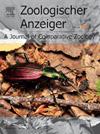腹足目:裸鳃鱼针状体的形态发生及化学组成
IF 1.5
3区 生物学
Q2 ZOOLOGY
引用次数: 0
摘要
在软体动物中,坚硬的骨骼元素普遍存在。这些结构通常在细胞外合成,如Polyplacophora、Caudofoveata和Solenogastres。然而,某些异支腹足类动物,如裸鳃、Acochlidimorpha、rhodopemorpha等,其表皮下的针状体在细胞内合成,并在整个个体发育过程中留在细胞内。在此,我们提供了来自3科4种裸鳃植物的针状体形态和形成的新数据:Acanthodoris pilosa (Abildgaard in m本文章由计算机程序翻译,如有差异,请以英文原文为准。
Morphogenesis and chemical composition of spicules in Doridina (Gastropoda: Nudibranchia)
Among molluscs, hard skeletal elements are widespread. These structures are typically external and synthesized extracellularly, as seen in Polyplacophora, Caudofoveata, and Solenogastres. However, certain heterobranch gastropods—such as Nudibranchia, Acochlidimorpha, Rhodopemorpha—have subepidermal spicules that are synthesized intracellularly and remain within cells throughout ontogeny. Here, we present new data on the morphology and formation of such spicules in four nudibranch species from three families: Acanthodoris pilosa (Abildgaard in Müller, 1789), Adalaria proxima (Alder and Hancock, 1854) (both Onchidorididae), Cadlina laevis (Linnaeus, 1767) (Cadlinidae), and Palio dubia (M. Sars, 1829) (Polyceridae). Using a combination of morphological methods and experimental techniques—including micro-computed tomography, light and confocal laser scanning microscopy, and scanning and transmission electron microscopy—we identified common patterns of spicule maturation and biomineralization, which affect spicules’ internal structure, and delineated their growth zones. Raman spectroscopy further revealed variability in the mineral composition of spicules across different dorid groups.
求助全文
通过发布文献求助,成功后即可免费获取论文全文。
去求助
来源期刊

Zoologischer Anzeiger
生物-动物学
CiteScore
2.80
自引率
7.10%
发文量
75
审稿时长
>12 weeks
期刊介绍:
Zoologischer Anzeiger - A Journal of Comparative Zoology is devoted to comparative zoology with a special emphasis on morphology, systematics, biogeography, and evolutionary biology targeting all metazoans, both modern and extinct. We also consider taxonomic submissions addressing a broader systematic and/or evolutionary context. The overall aim of the journal is to contribute to our understanding of the organismic world from an evolutionary perspective.
The journal Zoologischer Anzeiger invites suggestions for special issues. Interested parties may contact one of the editors.
 求助内容:
求助内容: 应助结果提醒方式:
应助结果提醒方式:


